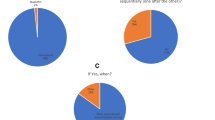Abstract
Objective
Ibuprofen is as effective as paracetamol (acetaminophen) as an antipyretic and analgesic agent in paediatric patients. Ibuprofen is considered to be well tolerated; however, there are reports on gastrointestinal bleeding or renal adverse effects among children treated with ibuprofen. Oral ibuprofen suspension was recently registered and approved by the Ministry of Health in Israel as an antipyretic and analgesic agent. Before distribution of the drug to pharmacies, we aimed to follow possible adverse effects among children receiving ibuprofen suspension in several paediatric wards and clinics.
Design
Children with fever needing antipyretic medication received ibuprofen oral suspension 5 to 10 mg/kg/dose. In each case the age of the patient, gender, diagnosis, number of ibuprofen doses, duration of treatment and any adverse reactions were reported.
Results
1564 children from 14 paediatric wards (11 hospitals) and from five paediatric and family clinics participated in the study; 882 males and 682 females. The patients, aged 3.6 ± 4.2 years (range 1 month to 16.5 years), received 2.4 ± 3 (range 1 to 22) doses of ibuprofen suspension for 1.56 ± 2.11 (range 1 to 20) days. Adverse reactions were reported among 26 patients (1.66%) [95% confidence interval (CI) 1.1–2.4]; 18 children (1.15%) [95% CI 0.7–1.8] vomited immediately after the administration of the drug and it was not readministered. Two children (0.12%) [95% CI 0.02–0.46] had abdominal pain that resolved spontaneously, two patients reported nausea, and two other children had diarrhoea. Eight children (0.51%) reported experiencing a ‘bitter taste’ from the medication, of whom one patient discontinued the medication while the other seven continued it.
Conclusions
The adverse reactions following administration of oral ibuprofen suspension reported in our study were low in frequency, mild and disappeared spontaneously. However, continuing reporting on its tolerability is needed.


Similar content being viewed by others
Notes
1Trade name is used for identification purposes only and does not imply product endorsement.
References
Heubi JE, Barbaci MB, Zimmerman HJ. Therapeutic misadventures with acetaminophen: Hepatotoxicity after multiple doses in children. J Pediatr 1998; 132: 22–7
Morton NS, Arana A. Paracetamol-induced fulminant hepatic failure in a child after 5 days of therapeutic doses. Paediatr Anaesth 1999; 9(5): 463–5
Vauzelle-Kervroedan F, d’Athis P, Pariente-Khayat A, et al. Equivalent antipyretic activity of ibuprofen and paracetamol in febrile children. J Pediatr 1997; 131(5): 683–7
Bertin L, Pons G, d’Athis P, et al. A randomized, double-blind, multicentre controlled trial of ibuprofen versus acetaminophen and placebo for symptoms of acute otitis media in children. Fundam Clin Pharmacol 1996; 10(4): 387–92
Autret E, Breart G, Jonville AP, et al. Comparative efficacy and tolerance of ibuprofen syrup and acetaminophen syrup in children with pyrexia associated with infectious diseases and treated with antibiotics. Eur J Clin Pharmacol 1994; 46(3): 197–201
Wilson JT, Brown RD, Kearns GL, et al. Single-dose, placebocontrolled comparative study of ibuprofen and acetaminophen antipyresis in children. J Pediatr 1991; 119(5): 803–11
Walson PD, Galletta G, Chomilo F, et al. Comparison of multidose ibuprofen and acetaminophen therapy in febrile children. Am J Dis Child 1992; 146(5): 626–32
Lesko SM, Mitchell AA. An assessment of the safety of pediatric ibuprofen: a practitioner-based randomized clinical trial. JAMA 1995; 273(12): 929–33
Harley EH, Dattolo RA. Ibuprofen for tonsillectomy pain in children: efficacy and complications. Otolaryngol Head Neck Surg 1998; 119(5): 492–6
Steans A, Manners PJ, Robinson IG. A multicentre, long-term evaluation of the safety and efficacy of ibuprofen syrup in children with juvenile chronic arthritis. Br J Clin Pract 1990; 44(5): 172–5
Kustra RP, Scott CS, Retsch-Bogart GZ. Safety of acute and chronic ibuprofen therapy in children. J Pediatr Pharm Pract 1996; 1(1): 30–5
Schaller S, Kaplan BS. Acute nonoliguric renal failure in children associated with nonsteroidal antiinflammatory agents. Pediatr Emerg Care 1998; 14(6): 416–8
Lesko SM, Mitchell AA. Renal function after short-term ibuprofen use in infants and children. Pediatrics 1997; 100(6): 954–7
Lesko SM, Mitchell AA. The safety of acetaminophen and ibuprofen among children younger than two years old. Pediatrics 1999; 104(4): e39
Moghal NE, Hulton SA, Milford DV. Care in the use of ibuprofen as an antipyretic in children. Clin Nephrol 1998; 49(5): 293–5
Flato B, Vinje O, Forre O. Toxicity of antirheumatic and anti-inflammatory drugs in children. Clin Rheumatol 1998; 17(6): 505–10
Giannini EH, Brewer EJ, Miller ML, et al. Ibuprofen suspension in the treatment of juvenile rheumatoid arthritis. Pediatric Rheumatology Collaborative Study Group. J Pediatr 1990; 117(4): 645–52
St Charles CS, Matt BH, Hamilton MM, et al. Comparison of ibuprofen versus acetaminophen with codeine in the young tonsillectomy patient. Otolaryngol Head Neck Surg 1997; 117(1): 76–82
Kokki H, Hendolin H, Maunuksela EL, et al. Ibuprofen in the treatment of postoperative pain in small children: a randomized double-blind-placebo controlled parallel group study. Acta Anaesthesiol Scand 1994; 38(5): 467–72
Hamalainen ML, Hoppu K, Valkeila E, et al. Ibuprofen or acetaminophen for the acute treatment of migraine in children: a double-blind, randomized, placebo-controlled, crossover study. Neurology 1997; 48(1): 103–7
Noyola DE, Fernandez M, Kaplan SL. Reevaluation of antipyretics in children with enteric fever. Pediatr Infect Dis J 1998; 17(8): 691–5
Mayoral CE, Marino RV, Rosenfeld W, et al. Alternating antipyretics: is this an alternative? Pediatrics 2000; 105(5): 1009–12
Acknowledgements
The study was supported by Teva-Abic Marketing Ltd, Netanya, Israel. The authors wish to thank Ms Hanna Gotlieb and Ms Pnina Mugami from Teva-Abic Ltd and Ms Malka Guttman from the Clinical Pharmacology Unit, Assaf Harofeh Medical Center, for supporting and encouraging this study.
Author information
Authors and Affiliations
Corresponding author
Rights and permissions
About this article
Cite this article
Berkovitch, M., Press, J., Bulkowstein, M. et al. Premarketing Surveillance of Oral Ibuprofen Solution in Febrile Children. Clin. Drug Investig. 21, 821–825 (2001). https://doi.org/10.2165/00044011-200121120-00004
Published:
Issue Date:
DOI: https://doi.org/10.2165/00044011-200121120-00004



